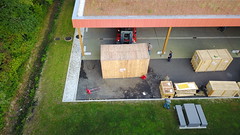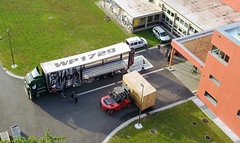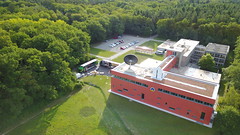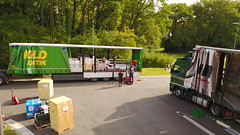Bye-bye ESPRESSO
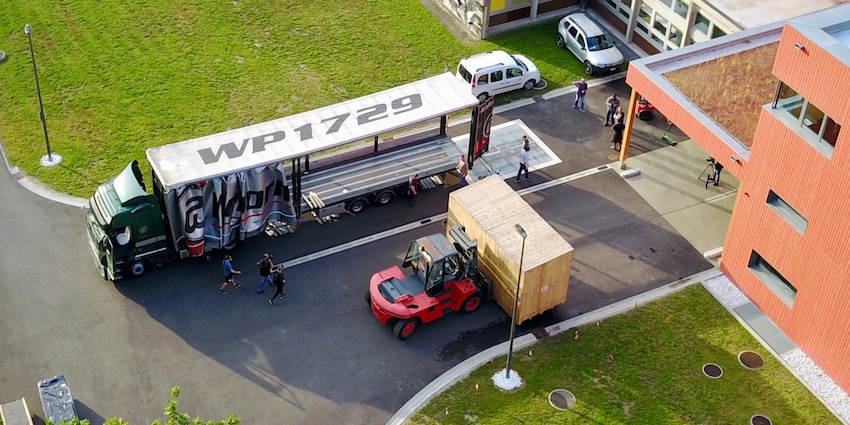
After almost 10 years of studies, construction, problems, efforts and sleepless nights, the ESPRESSO spectrograph left at the end of August the clean room of the Geneva Observatory to be installed on the 4 VLTs of the ESO Observatory at Paranal in northern Chile. A journey that has turned into a real saga.
If the ESPRESSO project started on 9 August 2009 with the signature of the contract for its construction between ESO and a consortium headed by Francesco Pepe of the Geneva Observatory and PlanetS, the ‘real’ ESPRESSO adventure began on 21 August 2017, when the instrument left Versoix on its journey to Chile. An adventure that has turned into a saga as unexpected and logistical difficulties have delayed and complicated the shipping.
Indeed, moving a 20-tons scientific instrument to Chile is not the same as sending a chocolate box to a cousin abroad. ESPRESSO had first to be disassembled piece by piece, an operation that took at least two weeks, before the delicate and precious components could be carefully packed in dozens of crates, most of which were equipped with shock sensors. Each crate weighs several hundred kilos or more, the biggest actually containing the vacuum chamber of more than 5 tons. The 40 crates were split in two batches, one containing the lighter and less bulky external parts of the instrument to be installed first at Paranal, the other collecting the heavy parts (vacuum tank, optical bench) and the optical components.
Once all the parts were packed and the boxes labelled, the team called on the carrier to ship the instrument. A rather complicated journey, since the ESPRESSO crates had to be loaded on trucks to be transported to Luxembourg. From the capital of the Grand Duchy, they would leave by cargo plane in direction of Miami, would be transferred to another airplane, and finally flown to Santiago de Chile. In Santiago, just after custom clearance, several trucks would wait for the load and undertake the last 1300 km move to Paranal.
A manageable journey, a priori, but which has turned slowly into a real saga that kept the whole team, in particular Ian Hughes (integration and logistics manager) and Denis Megevand (project manager), hard at it for long days (and nights).
Yet everything started relatively smoothly, since the first batch arrived in time in Santiago. The relief, however, was short-lived: indeed several boxes were damaged and others had their shock sensors activated. Fortunately, the damages turned out to concern only the wooden crates, but the ESPRESSO team members still broke out in a cold sweat when they learned of new customs problems and an on going strike of the Chilean truckers. Many mails and Skype-chats later, all came back into order and the first batch of crates arrived eventually at Paranal.
Shipping of the second batch, which contained the two largest crates (vacuum tank and optical bench) and delicate optical components, was clearly more epic. The problems started already in Versoix when the trucker had to raise the height of the truck roof to be able to load the vacuum tank box . After stowing all the crates the trucks could finally leave, but while being ‘en route’ to Luxembourg already for an hour, the carrier announced that the flight to Miami had been postponed for a week due to Hurricane Irma. It became thus necessary to call the truck back to Geneva for unloading, but once it had been unloaded, the ESPRESSO team learned from the carrier that the flight had actually been confirmed … After a second and long loading, the truck finally left for Luxembourg where a new troubles were awaiting. In fact, the large vacuum tank crate was not fitting through the airplane’s side door since it was 6 cm too high! What to do with the vacuum tank and all the other crates? Building a new wooden case would cost money and time, which in turn would call for high storage costs of the load at the airport and, even worse, for dramatic cancellation costs for the booked flight to Miami. ‘Fortunately’, Hurricane Irma raging over Florida lend a hand to ESPRESSO, since all flights to Miami were eventually put on hold for a week, which left to the ESPRESSO team some precious time to find a solution.
The problem of the big box being too big, however, remained to be solved. After endless mail, Skype and telephone exchanging, it was decided to remove the wooden ceiling and the walls of the box and send the “bare” vacuum tank on only its transportation platform. It was decided that, for more security, Ian Hughes would nevertheless accompany the crates on the cargo planes all the journey along to Santiago and Paranal. So he left home within two hours – taken by his wife and the two kids over a 100 km dive to the Geneva airport – for Luxembourg, where he learned that he could not board the plane because of the missing authorization of US homeland security.
The airplane carrying ESPRESSO’s second batch finally took off from Luxemburg on September 13. Due to heavy backlog, it was ‘peacefully’ stored for more than a week and left Miami only on the night of September 21 to arrive finally at Santiago on the 22. Was this the (happy) end of the story? Certainly not! Half of the crates have been damaged on their way to Santiago, and many of them show activated shock sensors. Given the status of the crates and due to late arrival of the custom papers, the ware could not be custom-cleared on the same day (Friday), so that it had to wait for the following Monday. At least, this leaves time to Ian Hughes to fly from Paranal to Santiago and verify integrity of the components (at least externally), before being loaded on the three trucks! In fact, the carrier organized a special convoy to cover the 1300km between the Chilean capital and the VLT site. Given the special character and the size of the boxes and crates, the convoy will move at the safe speed of 50km/h! Arrival scheduled for September 27, one month after departure from Geneva.
When everything will be unpacked and verified at Paranal, the integration of ESPRESSO will finally be able to start. The consortium’s engineers, technicians and astronomers, who have been preparing its installation for years, are already on site and are eagerly awaiting the instrument. They will have two months to put everything together; the first light is indeed scheduled for November 27.
ESPRESSO is a high-precision spectrograph built by a consortium under the direction of the Principal Investigator Francesco Pepe of the Geneva Observatory and PlanetS. It will be installed on ESO’s VLTs in Chile. It has been designed to measure radial velocity variations of stars with a precision of 10 cm s-1.
The consortium consists of the University of Geneva and Berne for Switzerland, the Astrophysics Institute for the Canary Islands (IAC), the Trieste and Brera Observatories of INAF for Italy and the Porto Astrophysics Center the Faculty of Science of Lisbon for Portugal. ESO, which, although not formally part of the consortium but associated partner, provides subsystems and is represented on the consortium’s executive board.
